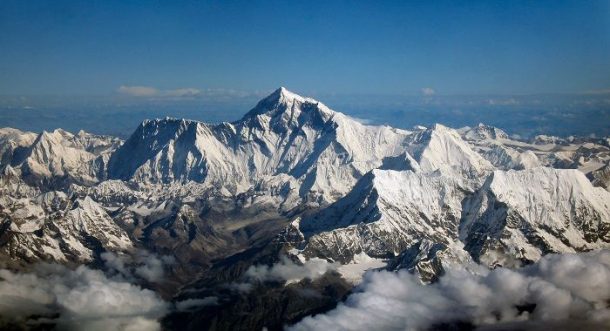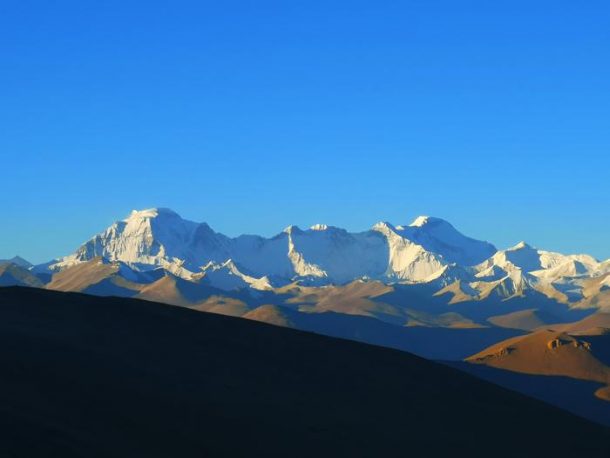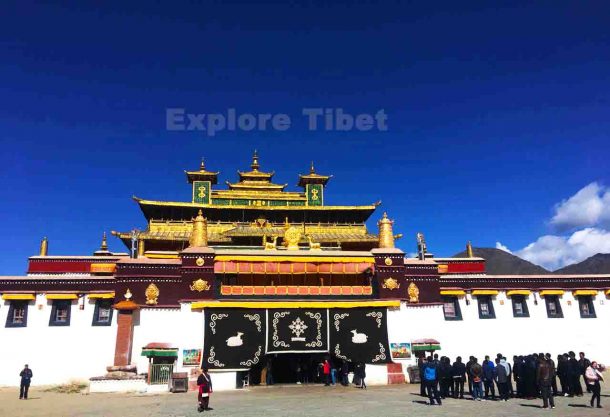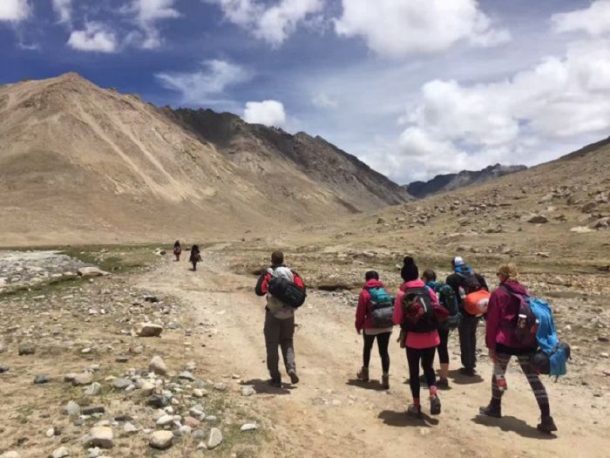
What Makes a Tibet Tour So Unique?
Tibet tour is a very different kind of vacation than you will find anywhere else in the world. Tibet is lying on the high-altitude plateau in the far west of China, this unique region is renowned for its Buddhism practices, which are an integral part of the Tibetan culture. For the Tibetan people, their Buddhist faith can be found in everything they do, from sunrise to sundown, and in every aspect of their lives.

Aerial view of the Himalayas
The region itself is also very unique in its geography and topography, being on the world’s highest plateau, fringed by the massive Himalayan Mountain Range. Running from the northwesternmost point of the region, the Himalayas run down the western edge of Tibet, turning to head east not far from the site of Mount Everest, and running all the way along the southern border with India and Bhutan, and on into the Chinese provinces of Sichuan and Yunnan. Tibet is surrounded by mountains which is why its called land of snow. All of this makes the plateau region a unique place to visit, where you can climb around high mountains. By visiting innumerable Buddhist monasteries, and experience this unique culture first hand. Every year thousands of domestic and international tourists visit Tibet and experience their unique culture and priceless landscapes.
The Unique region of Tibet
Tibet is made up of seven separate prefectures, of which only one is an actual prefecture, while the other six are prefecture-level cities. Carved out of the former Tibetan regions of U-Tsang, Amdo, and Kham, the prefecture divisions are now Lhasa, Shigatse, Chamdo, Nyingchi, Shannan, Nagqu, and Ngari, the only actual prefecture.
Lhasa is an area that is filled with mountains, and incorporating one of the largest lakes in the region, Lake Namtso. It is the highlight of the Tibet tour. The main area of the Nyenchen Tanglha Mountains, the city lies in the valley of one of the main tributaries of the Yarlung Zangbo River, which later becomes the Brahmaputra. To the east lies Nyingchi, another mountainous area of Tibet, with some of the best alpine scenery in the world, though with most of the land being at elevations much lower than the rest of Tibet.

The majestic mountain ranges in Tibet.
To the south of Lhasa lies Shannan, lying on the edge of the southern Himalayas, bordering on India and Bhutan and with a geography that ranges from high mountains to flat plains, and is known as the cradle of Tibetan civilization. To the west of Lhasa, lies the prefecture of Shigatse, the home of Mount Everest, and bordered to the west and south by the Himalayas. The area is one of the farming centers of Tibet, with huge expanses of barley fields surrounding the city itself, providing much of the staple barley for the plateau.
North of Shigatse is Ngari Prefecture, one of the most decollate of all the areas of Tibet, running all the way north to the edge of Xinjiang Province of China, and the home of the world’s most sacred mountain, Mount Kailash. North of Lhasa lies Nagqu prefecture, one of the least populated places on the plateau, filled with vast expanses of grasslands and prairies, and mostly peopled by Tibetan nomads, who run their herds of yaks across the plains throughout the summer months.
The Unique Spiritual Realm of Tibetan Buddhism
Tibet is the spiritual home of Tibetan Buddhism and is one of the most devout Buddhist regions in the world, where the religion is so much a part of the daily life of the Tibetan people that it is hard to distinguish religious practices from cultural traditions. The two go hand in hand so well, that the everyday lives of the Tibetan people are led by their devout beliefs.
Tibetan life is filled with rituals from their Buddhist faith, with a wide variety of customs that pervade their lives in every way. From the rituals that go alongside the harvest, where groups of Tibetan women walk around the fields to bless the harvest before it is reaped, to the habitual kora treks that many Tibetan people make as pilgrimages to the most sacred sites in the plateau, often covering thousands of kilometers on foot to get there. The land is as much a part of the Tibetan people as their religion and is revered in Tibetan Buddhism as sacred, which can be seen in the way the Tibetan nomads rotate their grazing lands regularly, to enable those that are already used to recover and become more fertile again. Environmental farming has been a part of Tibetan life for thousands of years before it became popular in the west, in the last few decades.

One of oldest Tibetan Buddhist Monastery in Tibet.
One of the most intense areas in the world in terms of the number of active Buddhist monasteries per square kilometer, Tibet has a huge number of great and small monasteries, all of which are well worth a visit. From the stunning monasteries of Lhasa, which includes Sera, Drepung, and Ganden monasteries, the major monasteries of the Gelug School of Tibetan Buddhism, to the far-flung monasteries of Rongbuk, in the shadow of Mount Everest, and Dzultripuk and Drirapuk at the foot of Mount Kailash. Everywhere you go, Tibetan Buddhist monasteries can be found in almost every town and city, and several lying on the slopes of high mountains in some of the most remote areas of the plateau.
Unique Tour Activities on the Tibetan Plateau
Tibet has a wealth of activities for travelers heading for the plateau, with more things to see and do than can be accommodated in just one trip. In order to get the best of the plateau, travelers can spend an entire lifetime exploring its unique sights, and amazing features, and yet still not know all of it well enough.
Some of the most popular activities for tours of Tibet include visits to some of the most sacred sites in the world, including the famous Jokhang Temple and Mount Kailash. Located in Lhasa, the Jokhang Temple is one of the oldest temples in Tibet, built in the seventh century by the Tibetan King, Songtsen Gampo, to house the statue of Buddha brought to the region from China by his wife, Princess Wencheng of the Tang Dynasty. Known as the most sacred building in Tibet, it is a regular destination for Tibetan pilgrims.

Tourists trekking on the kora route around Mount Kailash
Out in the far western area of Ngari Prefecture of Tibet lies the world’s most sacred mountain, Mount Kailash, revered in four religions as the center of the universe and the home of Gods. The highest mountain of the Gangdise Range, this sacred mountain has never been climbed, but is one of the world’s most popular pilgrimage destinations, with its 52-kilometer circuit for the ritual Buddhist kora.
Tibet is also renowned for its lakes, two of the most sacred of which lie within a short distance of Lhasa. To the north lies Lake Namtso, the Heavenly Lake, while to the southwest is Lake Yamdrok, created from the earring of a goddess. In the far west of Tibet, close to the sacred Mount Kailash, lies the holy Lake Manasarovar, also sacred to the four religions, Hinduism, Buddhism, Jainism, and Bonpo. In Tibet, all lakes are sacred, and most have their own kora routes around them, which are popular with both Buddhist and Hindu pilgrims, especially at Manasarovar.
Another popular activity in Tibet is the high-altitude trekking that can be found in many of the areas of the Himalayas, as well as around certain sacred and holy sites across the region. Some of the most popular treks in Tibet include the trek from Old Tingri to the Everest Base Camp (EBC), a trek of around 70 kilometers, and the treks through the Gama Valley, close to the foothills of the Himalayas in the Everest region. There are also popular treks in the area around Lhasa, such as the route from Ganden Monastery to Samye Monastery in Shannan prefecture, to the south of the capital.
Recent Posts
The Ultimate Guide to Tibet Tours, Travel, and Trekking Adventures
How to Explore Tibetan Culture
Exploring Lhasa:The Heart of Tibet
All Categories
- About Tibet
- book a Tibet tour
- Buddhism Practice
- Budget Tour
- China-Tibet Train
- Customized Tibet tour
- Historical Sites
- Hot Springs in Tibet
- News
- Photography in Tibet
- Tibet attraction
- Tibet Group Visa
- Tibet Motorcycle Tour
- Tibet Small Group Tours
- Tibet Tours and Tibetan Tour Guide
- Tibet Train
- Tibet Travel FAQs
- Tibet Travel Information
- Tibet Travel News
- Tibet Travel Permit Update
- Tibet Travel Prices Rises
- Tibet Trek
- Tibet Trekking Tour
- Tibet weather and climate
- Tibet Wildlife animals
- Tibet Winter Tour
- Tibetan Buddhism
- Tibetan Cultural Features
- Tibetan Culture and Poeple
- Tibetan Festivals
- What to see in Tibet



